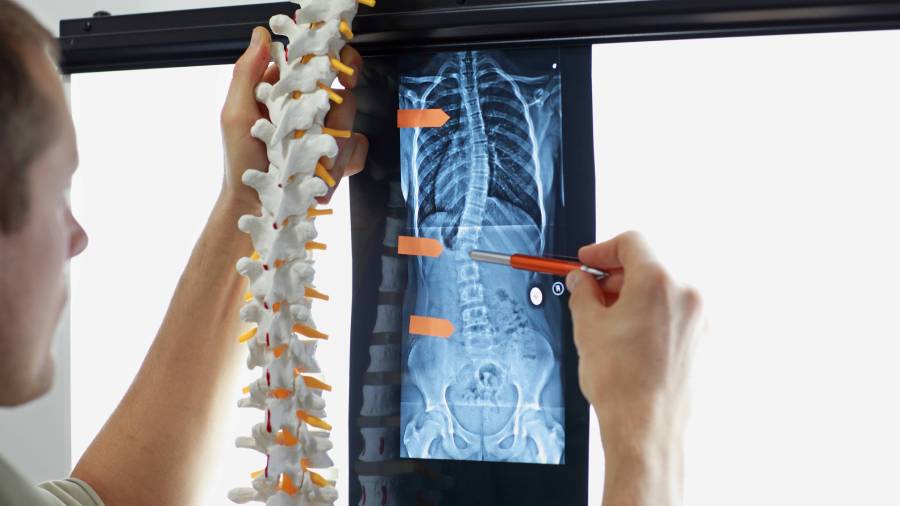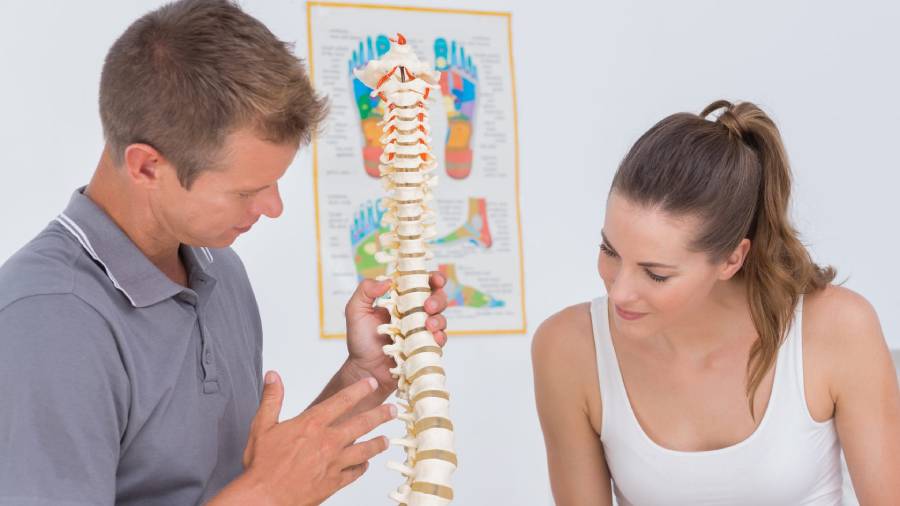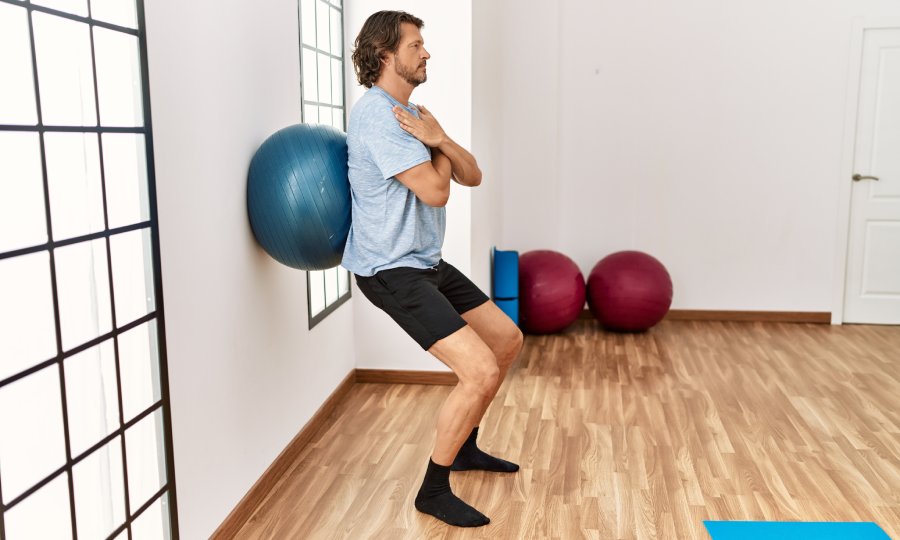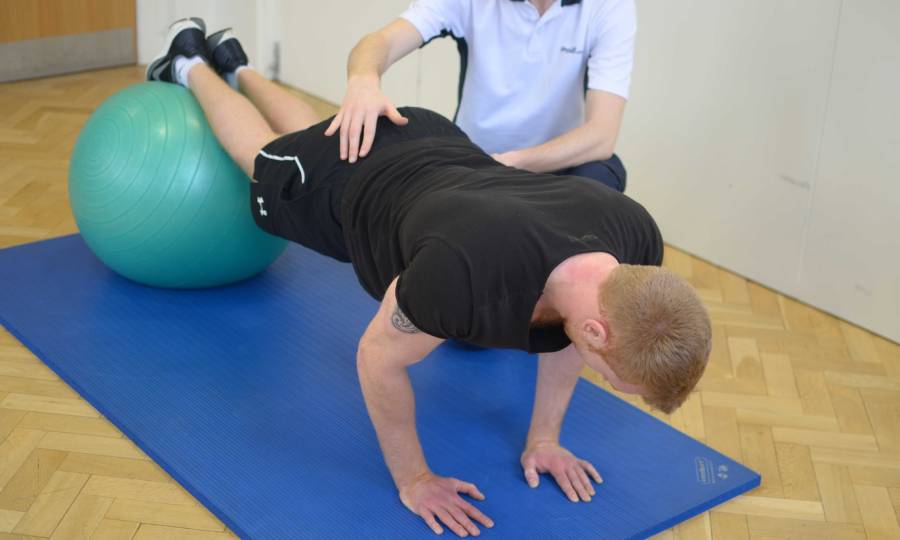Are you striving for returning to an active life after spine surgery using a metallic structure? You’re in for a long and complex rehabilitation process, but the correct approach can significantly improve the quality and speed of recovery. In this article, we will examine all the key aspects of this process to help you take the first steps towards a normal life.
Spine Surgery with a Metallic Structure

What is Spine Surgery with a Metallic Structure?
Spine surgery using a metallic structure is a surgical procedure in which doctors use metal implants to stabilize and support the spine. This type of surgery, also known as spinal fusion or arthrodesis, is usually performed to treat serious medical conditions such as severe degenerative disc changes, complex spine fractures, tumors, spinal deformities (like scoliosis or kyphosis), and certain types of chronic back pain.
During the surgical operation, doctors create a solid bridging connection between two or more adjacent vertebrae. They use metal implants such as screws, rods, or plates, which are attached to the vertebrae. This helps provide stability and prevents further movement of the vertebrae. In some cases, bone grafts may be placed between the vertebrae to stimulate the fusion process and create a single bone block.
After the surgery, patients typically require a significant amount of time for recovery as the bones need time to fuse and stabilize. During this process, it’s important to participate actively in rehabilitative exercises and comply with all doctors’ recommendations to ensure the best surgical outcome and prevent possible complications.
Purpose and Application of the Metallic Structure
Metallic structures are used to stabilize and strengthen the spine in cases of severe diseases such as scoliosis, disc herniation, or spondylolisthesis. This helps to reduce pain and prevent further spinal damage.
Postoperative Aspects: Key Rehabilitation Aspects

Early Rehabilitation Period Restrictions and Recommendations
An important part of early recovery after spine surgery using a metallic structure is adhering to a set of restrictions and recommendations that help prevent complications and provide the best conditions for successful recovery.
- Limiting physical activity: It is crucial to avoid excessive physical strain in the first few weeks after surgery. This includes lifting heavy objects, sudden movements, or any activity that can strain your spine.
- No bending, twisting, or tilting of the torso: These movements can strain the operated section of the spine and interfere with the recovery process.
- Avoiding prolonged sitting: The sitting position can increase pressure on the spine. It is recommended to stand up regularly and walk a little.
- Wearing a postoperative brace: The brace helps to keep the spine in the correct position, reduces pain, and minimizes the risk of complications.
- Maintaining personal hygiene: The early postoperative period requires special attention to hygiene to prevent infections, especially around the surgical area.
- Taking medications as prescribed by the doctor: It is necessary to adhere to the regimen of taking medications to manage pain syndrome, prevent inflammation, and stimulate the healing process.
- Participation in a physical rehabilitation program: Start rehabilitation exercises only on the doctor’s recommendations. Initial exercises should be gentle and aimed at improving circulation and preventing muscle stiffness.
Wearing a Postoperative Brace Period
Wearing a brace after spine surgery with a metallic structure plays a vital role in the recovery process. The brace helps to keep the spine in the correct position, reduces the load on the operated area, and prevents unwanted movement that can interfere with the healing process.
The period of wearing the brace varies depending on the nature of the surgery, the patient’s condition, and individual features of the recovery process. In most cases, the brace is worn from several weeks to several months after the surgery. The doctor will determine the optimal period of wearing the brace based on the specifics of each case.
It should be noted that constant wearing of a brace can lead to weakening of the back muscles, so it is important to switch gradually to wearing it only during strain-inducing exercises or activities. Physical exercises and therapy also play a crucial role in strengthening the back muscles and correcting posture.
Wearing a brace should be comfortable. If the brace causes pain, chafes or pinches the skin, you should consult a doctor for adjustment. Moreover, it is essential to care for the skin under the brace, regularly checking for irritation or circulation problems.
Despite possible inconveniences, wearing a brace is a crucial step in recovery after spine surgery, which contributes to quick and safe healing.
Recovery of Motor Activity
Restoring motor activity is a key component of rehabilitation. Starting with simple exercises, you gradually regain the ability to move without pain and discomfort.
Physical Rehabilitation

The Role of Physical Therapy in the Recovery Process
Physical therapy helps facilitate the recovery process by improving strength, flexibility, and general physical shape. This is an essential part of the journey back to a full, active life.
Types of Exercises and Their Importance
A crucial part of rehabilitation after spine surgery with a metallic structure is the restoration of motor activity. A series of exercises can help improve mobility, strengthen muscles, and enhance the patient’s general condition.
Keep in mind that all exercises should be performed under the supervision of a doctor or a qualified physiotherapist. They should be carried out carefully and without feeling pain. If an exercise causes pain, it should be stopped and discussed with your rehabilitation specialist.
Here are some examples of exercises that may be included in your rehabilitation program:
- Walking: Walking is a safe and effective way to increase mobility and strengthen the muscles of the back and legs. Start with short walks, gradually increasing the distance and speed.
- Stretching Exercises: Stretching exercises can help reduce tension and improve muscle flexibility. Examples include gentle stretching exercises for the neck, shoulders, arms, and legs.
- Strength Training Exercises: Strength training exercises help improve spine support and reduce strain on it. This may include core and leg muscle strengthening exercises, such as gentle abdominal exercises or exercises with rubber expanders.
- Breathing Exercises: Breathing exercises help improve metabolism, promote better oxygen supply to tissues, including the damaged areas of the spine.
- Exercises to Improve Coordination and Balance: Improving coordination and balance helps prevent falls and injuries. This may include stability exercises such as standing on one leg under therapist supervision.
Remember, each patient is unique, and the exercise program should be individualized, based on the specifics of the surgery, the patient’s general condition, and recovery progress.
Gradual Increase in Physical Activity
Recovery after spine surgery with a metallic structure requires a careful and consistent approach to increasing physical activity. The goal is to gradually revive mobility and strengthen muscles, while avoiding injury and pain.
Week 1-2: The first weeks after surgery usually involve minimal physical activity to allow the spine time to heal. This may include simple mobility exercises such as moving arms and legs, as well as walks over short distances.
Week 3-4: As the spine begins to heal, physical activity can start to increase. This may involve increasing the duration and intensity of walks, as well as starting light gymnastics and stretching exercises.
Week 5-6: At this stage, work can begin on muscle strengthening. This may include exercises using body weight or gentle exercises with rubber expanders.
Week 7 and beyond: As the condition improves, the intensity of exercises can be increased, and new exercises aimed at strengthening the core muscles, improving flexibility, and coordination can be included in the program.
It is important to remember that the entire process should take place under the supervision of a doctor or rehabilitation specialist, and no exercise should cause pain. Each person is unique, so your recovery plan may differ from the one described above. The main thing is to listen to your body and not rush. Gradually increasing physical activity will help you return to a full life after spine surgery.
Video: “Rehabilitation after Spine Surgery with a Metallic Structure”
Lumber Spine: Set No1 General rehabilitation and support. Initial stage.
For additional information about the rehabilitation after spine surgery with a metallic structure you can watch a video demonstrating exercises and rehabilitation recommendations.
Diet and Rest Regime

Importance of Balanced Nutrition for Recovery
Nutrition plays a key role in the recovery process after spine surgery with a metal structure. A properly balanced diet can help facilitate the healing process, strengthen the immune system, manage inflammation, and prevent excess weight, which is particularly important for maintaining a healthy spine.
- Proteins: Proteins play an important role in tissue regeneration and wound healing. Good sources of protein are meat, fish, eggs, dairy products, and legumes.
- Vitamins and minerals: Vitamins A, C, and E, as well as zinc and magnesium, help improve the healing process and strengthen the immune system. Fruits, vegetables, nuts, grains, and seafood are excellent sources of these vitamins and minerals.
- Complex Carbohydrates: Complex carbohydrates, such as grains, vegetables, and legumes, provide the body with long-lasting energy needed for the recovery process.
- Healthy fats: Healthy fats, such as omega-3, help reduce inflammation and support overall health. They are found in fish, nuts, and avocados.
- Water: Drinking enough water is extremely important for general health and recovery. Water helps maintain metabolism, eliminates toxins from the body, and supports the functions of all the body’s main systems.
Despite the importance of balanced nutrition, any significant changes in the diet should be discussed with your treating physician or dietitian. This is especially important if you have any existing health conditions or are taking any medications.
Role of Proper Sleep and Rest
Sleep and rest play a critically important role in the rehabilitation process after spine surgery with a metal structure. The recovery of physical activity requires energy and time, both of which are provided by quality sleep and adequate rest.
- Sleep for recovery: During the sleep, active recovery of the body takes place. This is the time when our bodies are engaged in repair and tissue regeneration, including areas damaged during the surgery. Proteins are synthesized for muscle repair, while hormones such as growth hormone are actively released to help in the healing process.
- Rest to reduce stress: Reducing stress levels is also a key aspect of recovery. Stress can slow the healing process and increase inflammation, so it’s important to take time for rest and relaxation.
- Proper sleep positions: After spine surgery with a metal structure, it’s important to pay attention to your posture during the sleep. The position should provide support for the back and avoid unnecessary pressure on the spine.
- Regular sleep schedule: Maintaining a regular sleep schedule can also help in recovery. This helps regulate the internal biological clock, which promotes better sleep quality and overall health.
In addition to sleep and rest, some people may find that various relaxation methods, such as meditation, breathing exercises, or warm baths, are helpful. However, before starting new practices, always discuss this with your treating physician.
Medication support

Drugs used in the rehabilitation process
During recovery from spine surgery with a metal structure, various drugs may be used to reduce pain, manage inflammation, support tissue healing, and facilitate recovery. Below are some commonly used medications and their purposes:
- Analgesics: Medications such as Paracetamol or Ibuprofen are used to manage pain after surgery. They block the production of prostaglandins in the body, substances that cause pain and inflammation.
- Anti-inflammatory drugs: NSAIDs (non-steroidal anti-inflammatory drugs), such as Diclofenac or Naproxen, may be used to reduce inflammation and pain.
- Muscle relaxants: Drugs such as Baclofen or Tizanidine may be used to reduce muscle spasms and relieve pain.
- Corticosteroids: In some cases, corticosteroids such as Prednisolone may be used to reduce inflammation and improve mobility.
- Tissue healing drugs: Vitamin C, zinc, as well as specific wound healing drugs such as Solcoseryl, may be recommended to support the healing process.
- Dietary supplements and vitamin complexes: Dietary supplements containing vitamins D and B, calcium, and magnesium may be recommended to support bone health and the nervous system.
Remember that all medications should be taken strictly as prescribed by a doctor, who knows your medical history and can consider possible contraindications and interactions with other medications.
Psychological support in the rehabilitation process

The role of psychological support
Psychological support is a critically important component of successful rehabilitation after spine surgery with a metal structure. After all, rehabilitation is not only a physical but also an emotional process, and maintaining a healthy psychological condition can significantly aid in achieving a positive outcome.
- Managing anxiety and stress: Spine surgery and subsequent recovery can cause significant stress and anxiety. Psychological support can help manage these emotions, train stress management techniques, and provide necessary feedback and problem-solving.
- Maintaining motivation: Recovery after such surgery requires significant effort and patience, and maintaining motivation is the key. A psychologist can help set realistic goals and develop strategies for maintaining motivation throughout the process.
- Recognizing lifestyle changes: Spine surgery can significantly change a patient’s lifestyle, at least temporarily. Psychological support can help accept these changes and develop adaptive strategies to cope with them.
- Improving self-esteem: The psychological impact of trauma or chronic disease can negatively affect self-esteem. A psychologist can help improve self-esteem and strengthen confidence in one’s recovery abilities.
- Psychotherapy: In some cases, professional psychotherapy may be required. Psychotherapists can use various methods, such as cognitive-behavioral therapy or hypnosis, to help patients cope with emotional challenges and improve quality of life.
It’s important to remember that each patient is unique, and the approach to psychological support should be individualized. Psychological support should be a component of a comprehensive rehabilitation plan, and it should focus on meeting the individual needs and goals of each patient.
Returning to Everyday Life

Returning to Work and Physical Activity
Returning to work and physical activity after spine surgery with a metal structure is an important stage in recovery. However, this should be gradual and under the supervision of specialists.
- Assessment of working conditions: Before returning to work, it’s important to assess working conditions and discuss them with your treating physician. Some jobs may require heavy physical labor or prolonged sitting, which may be contraindicated in the first months after surgery.
- Return to work: When returning to work, take into account the doctor’s recommendations, you may need a shortened working day or a change in duties. Listen to your body and avoid pain or discomfort.
- Recovery of physical activity: After surgery, it’s important to return gradually to physical activity. This will help strengthen muscles, maintain flexibility, and improve general physical condition. However, all activities should be adapted and moderate to avoid strain.
- Working with a physiotherapist: A physiotherapist can develop an individual recovery plan that takes into account your work, lifestyle, and goals. This may include exercises to improve strength, flexibility, endurance, and coordination.
- Adhering to safety rules: Always follow safety rules when returning to physical activity to avoid injuries. This may include using appropriate equipment, performing warm-ups and cool-downs, and respecting your physical limitations.
It’s always important to discuss your return-to-work and physical activity plan with your doctor or rehabilitation specialist. They will be able to provide you with individualized advice and recommendations based on your health condition, profession, and lifestyle.
Conclusion
In conclusion, I would like to emphasize the importance of proper rehabilitation after spine surgery with a metal structure. This is a multifaceted process that includes physical therapy, balanced nutrition, adequate rest, medication and psychological support. Each of these elements has its important role in ensuring full recovery and returning to normal life.
After surgery, it’s important to utilize all available resources to support your recovery. At this stage, you can turn to video materials that will help you in the rehabilitation process. We recommend you watch the recovery videos after spine surgery with a metal structure. These video exercises are designed by specialists and can be an excellent addition to your rehabilitation plan.
Remember, your health and recovery is your responsibility. Use all available resources, and don’t hesitate to ask for help when necessary.
Check out the demo version of our sets of exercises for Cervical spine, Thoracic spine, Lumbar spine on YouTube.
You can find more information about Cervical spine, Thoracic spine, Lumbar spine in our Library of Articles.
Our website presents sets of exercises for the cervical spine, thoracic spine, lumbar spine in the following areas:
SET OF EXERCISES №1 FOR THE CERVICAL SPINE. INITIAL STAGE OF RECOVERY
SET OF EXERCISES №2 FOR THE CERVICAL SPINE. MID STAGE OF RECOVERY
SET OF EXERCISES №3 FOR THE CERVICAL SPINE. ADVANCED STAGE OF REHAB
SET OF EXERCISES №1 FOR THE THORACIC SPINE. IMPROVING THE DYNAMICS AND MOBILITY OF THE THORACIC SPINE
SET OF EXERCISES №2 FOR THE THORACIC SPINE. STRENGTHENING THE STABILIZING MUSCLES OF THE THORACIC SPINE AND SHOULDER GIRDLE
LUMBAR SPINE: SET №1 GENERAL REHABILITATION AND SUPPORT. INITIAL STAGE
LUMBAR SPINE: SET №2 GENERAL REHABILITATION AND SUPPORT. MID STAGE
LUMBAR SPINE: SET №3 GENERAL REHABILITATION AND SUPPORT. ADVANCED STAGE
LUMBAR SPINE: SET №4 TREATMENT OF HERNIATED DISCS
LUMBAR SPINE: SET №5 LUMBAR INSTABILITY REHABILITATION. THE EXERCISE SYSTEM IS AN ALTERNATIVE TO SURGERY
FQAs
1: What are the main goals of spine surgery using a metal structure?
The main goals of such surgery are to eliminate pain, restore spine mobility, and improve the patient’s quality of life.
2: When will I be able to return to work and regular life after surgery?
The timeline for returning to work and regular life varies and depends on the nature of your job, the speed of your recovery, and the doctor’s recommendations.
3: What factors can slow down the recovery process after spine surgery?
Answer: Non-compliance with the doctor’s recommendations, especially regarding physical activity and rest schedule. Poor nutrition, which does not provide the necessary nutrients for healing. Smoking and alcohol, which can slow down the healing and recovery process. Comorbid conditions such as diabetes, obesity, or heart disease. Stress and lack of psychological support, which can negatively impact the recovery process.



